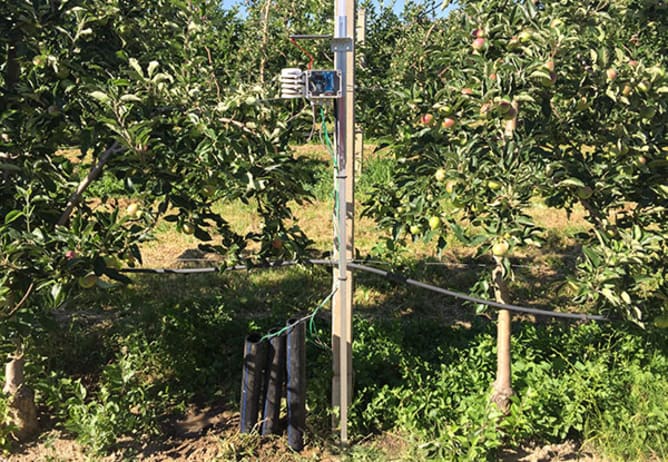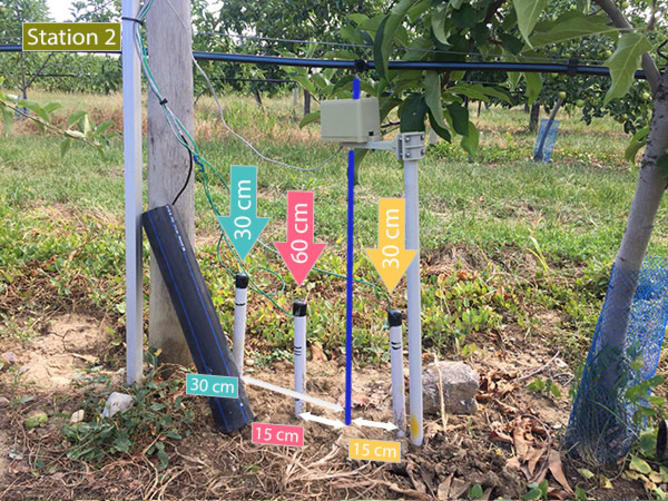JUSQU’A 30% D’ECONOMIE D'EAU
Le but de ce projet est de mettre en place une infrastructure IoT (internet of Things, ou Internet des Objets en français) , pour mieux surveiller l’humidité du sol des cultures et en temps réel. Ceci pour permettre aux producteurs
- de mieux planifier l’irrigation des cultures
- d’économiser l’eau et le coût de pompage
- d’augmenter le rendement du producteur
Une étude avec des producteurs de maïs à grande échelle au Nebraska a montré que la surveillance de l’irrigation basé sur des capteurs a permis d’économiser 30% d’eau et le coût du pompage a été réduit considérablement.
L’objectif de ce projet est donc d’arriver à ces résultats en utilisant la technologie promettante LoRaWAN, qui permet de transmettre les mesures des stations par radio dans un rayon de 3 à 10 kilomètres (en fonction de la configuration du terrain).
COMMENT VAIS-JE PROCÉDER? Avec la collaboration des producteurs, nous déterminerons les positions des stations. En fonction de votre structure, les capteurs WATERMARK seront placés à des profondeurs différentes pour surveiller le bulbe d’eau créé par le système d’arrosage. Comme détaillé dans la description approfondie (voir ci-dessous), les stations enverront les mesures à la passerelle qui elle, transmettra ces dernières au serveur distant. Ces mesures seront sauvées dans une base de données et une application web les exploitera pour les afficher sous forme de graphiques. Ultérieurement, je développerai un système d’alerte pour indiquer lorsque vos cultures devront être irriguées.

POURQUOI M'AIDER A VOUS AIDER
Votre soutien me permettra de payer ce prototype et j’espère à financer d’autres pour les installer dans d’autres cultures avec des configurations de terrains différents. Ceci est important car chaque installation me permettra de comparer des valeurs différentes et d’échanger avec les producteurs. Ainsi ces résultats me permettront de raffiner le fonctionnement des stations et de créer une version finale pour vous apporter de meilleurs résultats.
Le coût couvre initialement :
- une station-relay (ou une passerelle) avec une batterie 12V, un panneau solaire de 40W, un régulateur et un routeur 4G
- et 2-3 stations qui comprennent trois à douze capteurs (3 capteurs d’humidité du sol, un capteur pour compter les gouttes du système d’arrosage goutte-à-goutte, un capteur pour mesurer la température du sol. Un capteur pour mesurer la luminosité, la température de l’air, l’humidité extérieur, la pression, accessoirement un anémomètre). Finalement, un capteur pour mesurer les précipitations.
- Divers autres achats, comme une tarière, un lecteur digital WATERMARK, etc.
Pour le surplus, il servira à améliorer et compléter le prototype pour en faire une solution finale. Il servira aussi à acquérir un four à souder les circuits imprimés (PCB) afin de les faire moi-même et ainsi diminuer le coût de production.
DESCRIPTION PLUS APPROFONDIE
Bien qu’une variété de capteurs et de systèmes de collecte et d’analyse de données sont actuellement disponibles dans le commerce, leur adoption est encore limitée pour des raisons de coûts élevés, aux difficultés dans la collecte et l’interprétation des données en temps opportun. Ceci s’explique par des prix élevés, aux difficultés d’installation et de maintenance et à la difficulté de transmettre les mesures obtenues sur plusieurs kilomètres.
Le développement des microcontrôleurs à faible coût et OpenSource, leur capacité de gérer les technologies de communication sans fil, comme la radio, le téléphone cellulaire et le WiFi, offrent des possibilités très abordables. De plus, les récents développements dans les technologies de l’Internet des Objets (Internet-of-Things) utilisés dans une grande variété d’applications, tel que les maisons intelligentes ou les villes intelligentes, apportent un complément non-négligeable.
- réduire les coûts du pompage et économiser jusqu’à 30% d’eau.
- faciliter la collecte et l’interprétation des données
- visualiser l’état de ses cultures en temps réel
- mieux planifier l’irrigation des cultures
Afin de répondre à ces besoins, j’ai décidé de développer et tester un système IoT , pour répondre à ces besoins.
Les données provenant des capteurs attachés aux stations (émetteurs), sont transmises à la passerelle (récepteur) en utilisant la technologie radio LoRa, dans un rayon de 3 à 10 kilomètres (ceci dépend de la configuration du terrain). La passerelle, elle, traite et envoie instantanément les données sur un serveur/site web où les données pourront être visualisées et, analysées sous forme de graphique. Des alarmes pourront être paramétrées pour signaler une zone à irriguer ou observer le bulbe d’eau du goutteur.
Les stations sont constituées d’un microcontrôleur basé sur Arduino et de capteurs permettant de mesurer
- l’humidité du sol à 3 niveaux différents
- un compteur de gouttes lors de l’arrosage
- la quantité des précipitations
- l’humidité de l’air
- la température du sol
- la température de l’air
- la luminosité
- la pression
Les stations seront aussi équipées d’une carte SD pour avoir une sauvegarde supplémentaire des mesures.
La passerelle, quant à elle, est constituée d’un micro-ordinateur tel qu’un Raspberry Pi, d’un module supplémentaire (concentrateur) qui comporte le module radio.
La passerelle, tout comme les stations, sont en plus équipées d’un petit panneau solaire permettant d’assurer la longévité du système de surveillance.
QUI SUIS-JE ? Après une dizaine d’années de développement, notamment dans la réalisation de sites internet, je m’intéresse aux systèmes embarqués. Je commande mon premier microcontrôleur (Arduino) et je développe un tracker pour prévenir «les disparitions» des personnes âgées ou à mobilités réduites. Fort de ces quatre dernières années d’expériences avec ces technologies, ma curiosité m’oriente ensuite vers l’Internet des objets (IoT) et c’est là que naît le projet SMART IRRIGATION.


